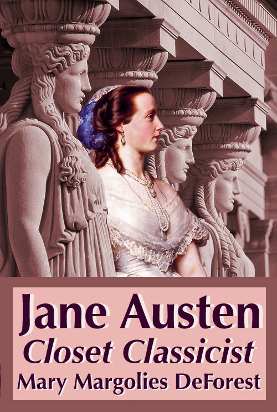|
|
|
|
Did she or didn't she?paperback kindle |
Jane Austen wrote in the horse-and-buggy days, before the car, the plane, the computer, and the Pill, the inventions that have defined modern society. Yet her characters seem as fresh as when they first stepped off the page.
The Latinometer™ opens a window onto her workshop where she forged the characters who still seem real after two centuries. Snobs like Sir Walter Elliot (Persuasion) and fake feminists like Mrs. Elton (of Emma) are alive and well even today.
If you followed people around with a tape recorder, they would not seem as real as Austen made her characters sound. The Latinometer™ shows how she played one side of the English language against the other.
|
|
Densities of Austen's Characters Low-Brow Density 11% Admiral Croft (P) 11% Dr. Grant (MP) 11% Mrs. Price (MP) 11% Lydia Bennet (P&P) 12% William Price (MP) 13% Lady Bertram (MP) 14% Lt. Price (MP) 14% Mrs. Jennings (S&S) 14% Anne Steele (S&S) 14% Sir John Middleton (S&S) 15% Mr. Rushworth (MP) 17% Mrs. Bennet (P&P) 17% Mrs. Palmer (S&S) 18% Harriet Smith (E) 18% Catherine Morland (NA) 19% Lady Middleton (S&S) 19% Captain Harville (P)
Middle-Brow Density 21% Mrs. Norris (MP) 21% Fanny Dashwood (S&S) 21% Mrs. Grant (MP) 22% Mrs. Croft (P) 23% Isabella Thorpe (NA) 23% Mr. Palmer (S&S) 23% Lucy Steele (S&S) 24% Mrs. Clay (P) 24% Maria Bertram (MP) High-Brow Density 24% Tom Bertram (MP) 25% Fanny Price (MP) 25% Mr. Bingley (P&P) 25% Julia Bertram (MP) 25% Elizabeth Elliot (P) 26% Mary Crawford (MP) 26% Frank Churchill (E) 26% Eleanor Tilney (NA) 27% Marianne Dashwood (in love, S&S) 27% Robert Ferrars (S&S) 27% Captain Wentworth (P) 27% John Dashwood (S&S) 28% Mr. Knightley (E) 29% Edward Ferrars (S&S) 29% Henry Crawford (MP) 29% Jane Bennet (P&P) 29% Emma (E) 29% Mrs. Elton (E) 30% Charlotte Lucas (P&P) 30% Edmund Bertram (MP) 30% Mrs. Dashwood (S&S) 30% Anne Elliot (P) 30% Willoughby (S&S) 30% Mr. Elton (E) 30% Mr. Darcy (at end of P&P) 31% Jane Fairfax (E) 31% Marianne Dashwood (in recovery, S&S) 33% Col. Brandon (S&S) 33% Lady Catherine de Bourgh (P&P) 33% Henry Tilney (NA) 34% Elizabeth Bennet (P&P) 34% Elinor Dashwood (S&S) 35% Marianne Dashwood (at start of S&S) 35% Sir Thomas Bertram (MP) 35% Lady Russell (P) Pretentious and Deceptive 36% Mr. Elliot (P) 38% Mr. Darcy (at the start of P&P) 40% Mr. Collins (P&P) 42% Mr. Darcy's letter 43% Mary Bennet (P&P)
|
Austen made 100 characters sound different from each other by varying the densities of words derived from the classical languages, which I have called "Latinate." Her readers speak with a higher density of Latinate words than non-readers read. The dividing line between readers and non-readers is around 22%, with the readers of better books around 24%.
It is no surprise that non-intellectual characters, like Mrs. Bennet of Pride and Prejudice, and Mrs. Jennings of Sense and Sensibility, have low densities.
One would expect Dr. Grant, a scholarly clergyman, to speak at a learned level of Latinity. That is doubtless his style in scholarly articles, but Austen shows him only among friends and family, where his sole topic of conversation is food.
Admiral Croft, too, seems misplaced, with a density close to that of the nitwit, Lydia Bennet of Pride and Prejudice. This is Austen's point: the British Navy, unlike the army, was a meritocracy. The worthless Wickham of Pride and Prejudice became an officer because Mr. Darcy paid for his commission. Admiral Croft rose to high power through energy and intelligence.
Mr. Darcy at first barricades himself behind a wall of Latinate words (at 38%), but when Elizabeth rejects him, the wall crumbles and he speaks at 30%, a much more comfortable level.
Caroline Bingley's first letter to Jane Bennet of Pride and Prejudice is cosily informal (18%); her second letter, when she is trying to shake Jane off, has a much higher density (36%).
See my book Jane Austen: Closet Classicist for more on how Austen organizes the two vocabularies around the following oppositions:
|
